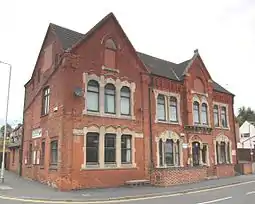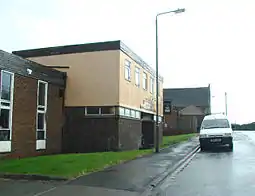Working men's club
Working men's clubs are a type of private social club first created in the 19th century in industrialised areas of the United Kingdom, particularly the North of England, the Midlands, Scotland and many parts of the South Wales Valleys, to provide recreation and education for working class men and their families. They also began at this time in Australia, with a small number in Ireland, primarily Dublin.

History
The first recorded working men's club opened in 1857 in Reddish. Gregg set it up for his workers. He identified that many of his workers were shut out of their lodging throughout the day and evening, with nowhere to cook or even read a newspaper, and were forced to spend their non-working lives in a public house. Greggs Reddish Working Man club aimed to give them somewhere to relax.[1] There are four working mens clubs in Reddish, this one, the North Reddish Working Men's Club and the architecturally significant Houldsworth Working Men's Club.[1]

Despite the original educational ambitions, most working men's clubs are now mainly recreational. Typically, a club would have a room, often referred to (especially in Northern England) as a vault, with a bar for the sale and consumption of alcohol, snooker, pool or bar billiards tables, as well as televisions for sport entertainment; many provide food. A much larger room would be connected, often called the concert or entertainment room, with a stage and a layout of tables, stools and backrest sofas. They often provide night time entertainment, mainly on the weekends such as bingo, raffles, live music cabaret and comedy, playing popular music. They are also known for their charitable works.
In recent years, declining membership has seen many clubs close down and others struggle to remain open.[2] Some groups try to raise the profile of clubs, pointing to their historical legacies and their community roles.
21st Century
Meanwhile, the 19th and early 20th century educational ambitions of working men's clubs have now returned in new organisations such as the men's shed movement that started in Australasia and has spread to Europe [3] and appeals to much the same community as working men's clubs. Similarly the growing hackerspace movement appeals mostly to younger working men and women, who forty years ago would have worked on their interests in their garden shed or garage and then met others of like mind at their local working men's club. However, with the rise in housing costs few younger people have access to such spaces, instead were being forced to use public spaces such as cafes prior to the introduction of shared facilities such as hackerspaces and men's sheds.

Membership and structure
Working men's clubs are cooperatives run by their members through a committee, usually elected annually. Each club has rules that tend to be vigorously enforced. The committee will discipline members (common punishments being a warning, or a ban for a period) for violations. Despite the name, women are allowed to be members in many clubs, and virtually all clubs allow entry to women. Non-members are not allowed entry unless signed in by a member.
In the UK they are registered as co-operatives under the Co-operative and Community Benefit Societies Act 2014, normally using model rules[4] supplied by the Clubs and Institutes Union.
A dispute at Wakefield City Workingmen's Club in 1978 led to a national campaign for equal membership rights for women. Sheila Capstick, whose husband was an activist in the NUM, had been a regular snooker player at the club before a ban was instituted on women playing snooker. Her protest A Woman's Right to Cues developed into a nationwide campaign for equal rights ERICCA – Equal Rights in Clubs Campaign for Action. In April 2007, after the resolution had been consistently rejected over years, the Club and Institutes Union accepted equal membership rights for women.[5]
Club and Institute Union
Most clubs affiliate to the Working Men's Club and Institute Union (commonly known as the CIU or C&IU). The CIU is affiliated to the Committee of Registered Clubs Associations or CORCA. A member of one affiliated club is entitled to use the facilities of other clubs. There are 2,200 affiliated working men's clubs in the UK.[6]
The CIU has two purposes: to provide a national voice for clubs, and to provide discounted products and services for clubs.
Brewery
Until 2004, clubs ran a brewery at Dunston, Tyne and Wear, which brewed ales and lagers under the Federation brand. The brewery and brands were sold to Scottish & Newcastle for £16.2 million,[7] although CIU clubs still receive discounted beer. These discounts are passed on to members.
Impact of July 2007 smoking ban
In December 2007 a poll by the British Institute of Innkeeping and the Federation of Licensed Victuallers Associations found that overall revenue was 7.3 per cent down as more men opted to drink at home, where they could also smoke.[8]
See also
References
- Scapens, Alex (29 August 2007). "Club celebrates its 150 year history". men. Retrieved 18 April 2020.
- "BBC News – Brewers call time on Barrow working men's club". BBC Online. 4 January 2013. Retrieved 6 January 2013.
Ken Brown, the Cumbria secretary for the Working Men's Club and Institute Union (CIU), said: 'Ten years ago there were more than fifty clubs affiliated to the CIU Cumbria, now we have 33.'
- "What is a Men's Shed". MensShed.org. Retrieved October 23, 2012.
- https://www.wmciu.org.uk/CIU%20Rules%202015.pdf
- "Club women win fight for equal rights at last". Yorkshire Post. Leeds, UK. 2 April 2007. Retrieved 9 April 2016.
- "Archived copy". Archived from the original on 2010-03-22. Retrieved 2010-08-09.CS1 maint: archived copy as title (link)
- "Scottish & Newcastle – Financial News". Scottish & Newcastle plc. 14 July 2004. Retrieved 12 September 2008.
- "Working men's clubs hardest hit by smoking ban". Daily Telegraph. 18 December 2007.